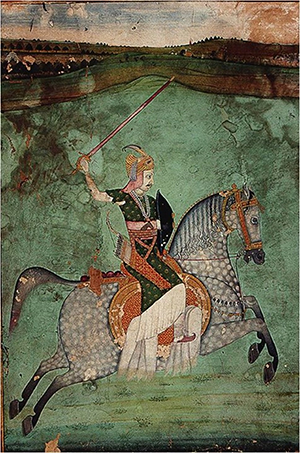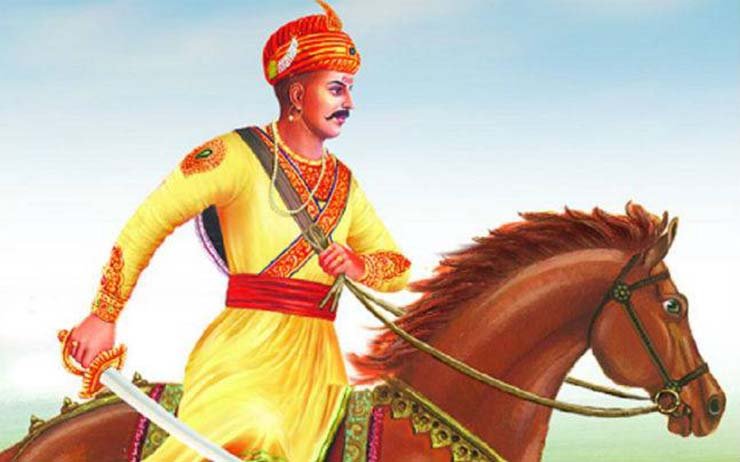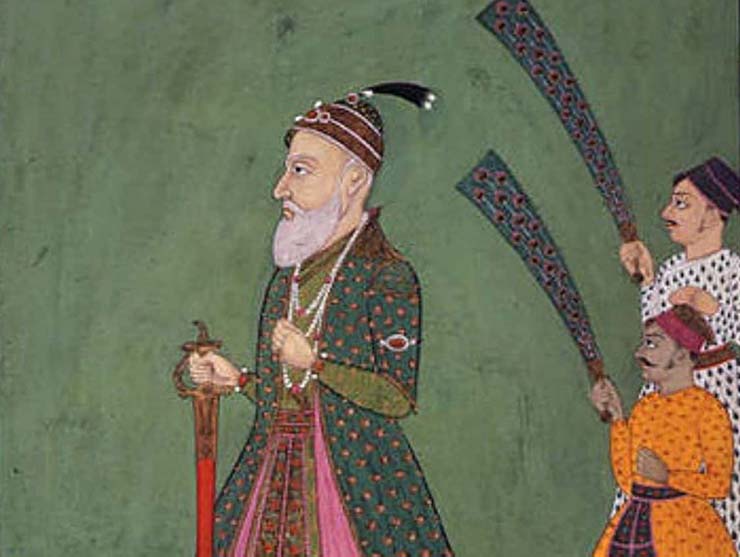 Baji Rao 1 is regarded as the most charismatic and dynamic leader in Maratha history after Shivaji. Baji Rao (18 August 1700 – 28 April 1740) is rated as one of the greatest military generals of his time. He was the Seventh Peshwa (Prime Minister) of the Maratha Empire. He defeated the Mughals and their vassal Nizam-ul-Mulk in several battles such as the Battle of Delhi and Battle of Bhopal during his 20-year tenure as the Peshwa.
Baji Rao 1 is regarded as the most charismatic and dynamic leader in Maratha history after Shivaji. Baji Rao (18 August 1700 – 28 April 1740) is rated as one of the greatest military generals of his time. He was the Seventh Peshwa (Prime Minister) of the Maratha Empire. He defeated the Mughals and their vassal Nizam-ul-Mulk in several battles such as the Battle of Delhi and Battle of Bhopal during his 20-year tenure as the Peshwa.
His leadership enabled the Marathas to establish supremacy in south India and political hegemony in north India. He was behind establishing the Maratha power in Gujarat, Malwa, Rajputana and Bundelkhand; and liberating Konkan (western coast of India) from the Siddis of Janjira and Portuguese rule.
Born as Visaji in a Marathi Hindu Bhat family in Sinnar near Nashik, he spent his childhood in his father’s newly-acquired fiefdom of Saswad and was inspired by the lives of Shivaji, Ramchandra Pant Amatya and Santaji Ghorpade. He was trained as a diplomat and a warrior under his father and his early education included reading, writing and learning Sanskrit but he did not remain confined to the books.
Baji Rao displayed a passion for the military at an early age and often accompanied his father Balaji Vishwanath on military campaigns. On the death of his father in 1720, the 20-year-old Baji Rao was appointed as Peshwa on April 17 that year despite opposition from other chieftains.
By the time of his appointment, Mughal ruler Muhammad Shah had upheld the Maratha claim to the territory held by Shivaji. A treaty gave the Marathas the right to collect taxes (Chauth) in the Deccan’s six provinces. Baji Rao convinced Shahu that the Maratha empire needed to be offensive against its enemies to defend itself. He knew that the Mughal empire was on the decline. So, he wanted to take advantage of the situation with aggressive expansion into North India. Baji Rao compared the Mughals’ declining fortunes to a tree that, if attacked at its roots, would collapse. “Let us strike at the trunk of the withering tree and the branches will fall off themselves. Listen but to my counsel and I shall establish the Maratha flag on the walls of Attock,” he said.
Early challenges
As the new Peshwa, however, he faced several challenges for his appointment at a young age had evoked jealousy among the senior officials. The Mughal envoy of the Deccan, Nizam-ul-Mulk Asaf Jah I, created a de facto autonomous kingdom in the region. On January 4, 1721, Baji Rao met Nizam-ul-Mulk Asaf Jah I at Chikhalthana to resolve their disputes. However, the Nizam refused to recognize the Maratha’s right to collect taxes from the Deccan provinces. He was made vizier of the Mughal empire in 1721 by Muhammad Shah, alarmed at his increasing power, transferred him from the Deccan to Awadh in 1723. The Nizam rebelled against the order, resigned as vizier and marched towards the Deccan. The emperor sent an army against him, which the Nizam defeated at the Battle of Sakhar-kheda. The Marathas, led by Baji Rao, helped the Nizam in the battle. For his valour, Baji Rao was honoured with a robe, a 7,000-man mansabdari, an elephant, and a jewel.
In 1725, the Nizam sent an army to clear Maratha revenue collectors from the Carnatic region. The Marathas dispatched a force under Fateh Singh Bhosle to counter him; Baji Rao accompanied Bhosle, but did not command the army. The Marathas were forced to retreat.
When the Nizam heard that his northern territories had been devastated by Baji Rao, he left Pune and marched towards the Godavari to meet Baji Rao on an open plain where his artillery would be effective. The Nizam went on ahead of his artillery; on February 25, 1728, the armies of Baji Rao and the Nizam faced each other at Palkhed, a town about 30 miles (48 km) west of Aurangabad. The Nizam was quickly surrounded by the Maratha forces and he was trapped, his lines of supply and communication were cut. He was forced to make peace; he signed the Treaty of Mungi Shevgaon on March 6, recognising Shahu as the King and the Maratha right to collect taxes in the Deccan.

Military strategy
This battle is considered an example of the brilliant execution of military strategy. In his Military History of India, Jadunath Sarkar wrote: “This campaign gives a classic example of what the predatory horse, when led by a genius, could achieve in the age of light artillery.”
After consolidating Maratha’s influence in central India, Baji Rao decided to assert the Maratha right to collect taxes from the wealthy province of Gujarat and sent a Maratha force under Chimaji Appa there in 1730.
Baji Rao learned that Dabhade and Gaikwad had made preparations for an open fight on the plains of Dabhoi with a force of 40,000 while Baji Rao’s numbers hardly reached 25,000 in all. Baji Rao repeatedly sent messages to Dabhade to solve the dispute amicably who remained stubborn disagreeing Baji Rao’s proposition. On April 1, 1731, Baji Rao struck at the allied forces of Dabhade, Gaekwad and Kadam Bande. The Dabhade was seated on an elephant and Baji Rao was on horseback. But during the battle, a bullet pierced Trimbakrao’s head and he died on the spot. Later it was discovered that the shot that killed Dabhade was fired by Dabhade’s maternal uncle Bhau Singh Thoke. Baji Rao resolved the dispute with Sambhaji II by signing the Treaty of Warna, which demarcated the territories of Shahu and Sambhaji II.
With Shahu’s consent, Baji Rao began a northward journey on October 9, 1735. Baji Rao’s dash on Delhi was executed in a manner that neither the Mughal generals nor the Mughal intelligence could comprehend or predict his moves.

Baji Rao besieged the Nizam, cutting off outside provisions. Due to Nizam’s artillery, the Marathas kept their distance and harassed their lines; no food could come in from outside, and the men and their animals were starving. The Nizam, unable to hold on any longer, signed a peace agreement at Doraha on January 7, 1738. Malwa was ceded to the Marathas; the Mughals agreed to pay the equivalent of Rs 5,000,000 in reparations, with the Nizam swearing on the Quran to abide by the treaty.
Rapid movement
Baji Rao was known for rapid tactical movements in a battle, using cavalry inherited from Maratha generals such as Santaji Ghorpade and Dhanaji Jadhav. His skill was in moving large numbers of cavalry at a high speed. British field marshal Bernard Montgomery studied Baji Rao’s tactics in the Palkhed campaign, particularly his rapid movements and his troops’ ability to live off the land (with little concern about supply and communication lines) while conducting ‘manoeuvre warfare’ against the enemy.
In his book, A Concise History of Warfare, Montgomery wrote about Baji Rao’s victory: “They (Marathas) were at their best in the 18th century, and the Palkhed campaign of 1727–28 in which Baji Rao I out-generalled Nizam-ul-Mulk, is a masterpiece of strategic mobility.
Baji Rao’s army was a purely mounted force, armed only with a sabre, lance, a bow, and a round shield. There was a spare horse for every two men. The Marathas moved unencumbered by artillery, baggage, or even handguns and defensive armour. They supplied themselves by looting.”
Jadunath Sarkar called Baji Rao, ‘a heavenly-born cavalry leader’.
– The writer is a senior journalist and media consultant. The views expressed are of the writer and do not necessarily reflect the views of Raksha Anirveda








